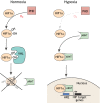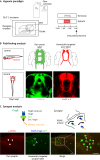Hypoxia and connectivity in the developing vertebrate nervous system
- PMID: 30541748
- PMCID: PMC6307895
- DOI: 10.1242/dmm.037127
Hypoxia and connectivity in the developing vertebrate nervous system
Abstract
The developing nervous system depends upon precise regulation of oxygen levels. Hypoxia, the condition of low oxygen concentration, can interrupt developmental sequences and cause a range of molecular, cellular and neuronal changes and injuries. The roles and effects of hypoxia on the central nervous system (CNS) are poorly characterized, even though hypoxia is simultaneously a normal component of development, a potentially abnormal environmental stressor in some settings, and a clinically important complication, for example of prematurity. Work over the past decade has revealed that hypoxia causes specific disruptions in the development of CNS connectivity, altering axon pathfinding and synapse development. The goals of this article are to review hypoxia's effects on the development of CNS connectivity, including its genetic and molecular mediators, and the changes it causes in CNS circuitry and function due to regulated as well as unintended mechanisms. The transcription factor HIF1α is the central mediator of the CNS response to hypoxia (as it is elsewhere in the body), but hypoxia also causes a dysregulation of gene expression. Animals appear to have evolved genetic and molecular responses to hypoxia that result in functional behavioral alterations to adapt to the changes in oxygen concentration during CNS development. Understanding the molecular pathways underlying both the normal and abnormal effects of hypoxia on CNS connectivity may reveal novel insights into common neurodevelopmental disorders. In addition, this Review explores the current gaps in knowledge, and suggests important areas for future studies.
Keywords: Connectivity; Hypoxia; Neuroscience; Pathfinding.
© 2018. Published by The Company of Biologists Ltd.
Conflict of interest statement
Competing interestsThe authors declare no competing or financial interests.
Figures



Similar articles
-
Hypoxia disruption of vertebrate CNS pathfinding through ephrinB2 Is rescued by magnesium.PLoS Genet. 2012;8(4):e1002638. doi: 10.1371/journal.pgen.1002638. Epub 2012 Apr 12. PLoS Genet. 2012. PMID: 22511881 Free PMC article.
-
Temporal Dysynchrony in brain connectivity gene expression following hypoxia.BMC Genomics. 2016 May 4;17:334. doi: 10.1186/s12864-016-2638-x. BMC Genomics. 2016. PMID: 27146468 Free PMC article.
-
Hypoxia and hypoxia-inducible factor-1 target genes in central nervous system radiation injury: a role for vascular endothelial growth factor.Clin Cancer Res. 2004 May 15;10(10):3342-53. doi: 10.1158/1078-0432.CCR-03-0426. Clin Cancer Res. 2004. PMID: 15161688
-
Differentiation of the vertebrate neural tube.Curr Opin Cell Biol. 1997 Dec;9(6):885-91. doi: 10.1016/s0955-0674(97)80092-0. Curr Opin Cell Biol. 1997. PMID: 9425355 Review.
-
Microglia: Architects of the Developing Nervous System.Trends Cell Biol. 2016 Aug;26(8):587-597. doi: 10.1016/j.tcb.2016.02.006. Epub 2016 Mar 20. Trends Cell Biol. 2016. PMID: 27004698 Free PMC article. Review.
Cited by
-
Interaction between the brain and multiple organ systems in schizophrenia.World J Psychiatry. 2025 Aug 19;15(8):107696. doi: 10.5498/wjp.v15.i8.107696. eCollection 2025 Aug 19. World J Psychiatry. 2025. PMID: 40837794 Free PMC article. Review.
-
Dopaminergic Co-Regulation of Locomotor Development and Motor Neuron Synaptogenesis is Uncoupled by Hypoxia in Zebrafish.eNeuro. 2020 Feb 27;7(1):ENEURO.0355-19.2020. doi: 10.1523/ENEURO.0355-19.2020. Print 2020 Jan/Feb. eNeuro. 2020. PMID: 32001551 Free PMC article.
-
Transient Hypoxemia Disrupts Anatomical and Functional Maturation of Preterm Fetal Ovine CA1 Pyramidal Neurons.J Neurosci. 2019 Oct 2;39(40):7853-7871. doi: 10.1523/JNEUROSCI.1364-19.2019. Epub 2019 Aug 27. J Neurosci. 2019. PMID: 31455661 Free PMC article.
-
Reduction of Deuterium Level Supports Resistance of Neurons to Glucose Deprivation and Hypoxia: Study in Cultures of Neurons and on Animals.Molecules. 2021 Dec 31;27(1):243. doi: 10.3390/molecules27010243. Molecules. 2021. PMID: 35011474 Free PMC article.
-
Oxygen enrichment protects against intestinal damage and gut microbiota disturbance in rats exposed to acute high-altitude hypoxia.Front Microbiol. 2023 Oct 12;14:1268701. doi: 10.3389/fmicb.2023.1268701. eCollection 2023. Front Microbiol. 2023. PMID: 37901817 Free PMC article.
References
-
- Bartoszewska S., Kochan K., Piotrowski A., Kamysz W., Ochocka R. J., Collawn J. F. and Bartoszewski R. (2015). The hypoxia-inducible miR-429 regulates hypoxia-inducible factor-1alpha expression in human endothelial cells through a negative feedback loop. FASEB J. 29, 1467-1479. 10.1096/fj.14-267054 - DOI - PMC - PubMed
Publication types
MeSH terms
Substances
Grants and funding
LinkOut - more resources
Full Text Sources
Miscellaneous

